Edelstein-Keshet L. Mathematical Models in Biology
Подождите немного. Документ загружается.

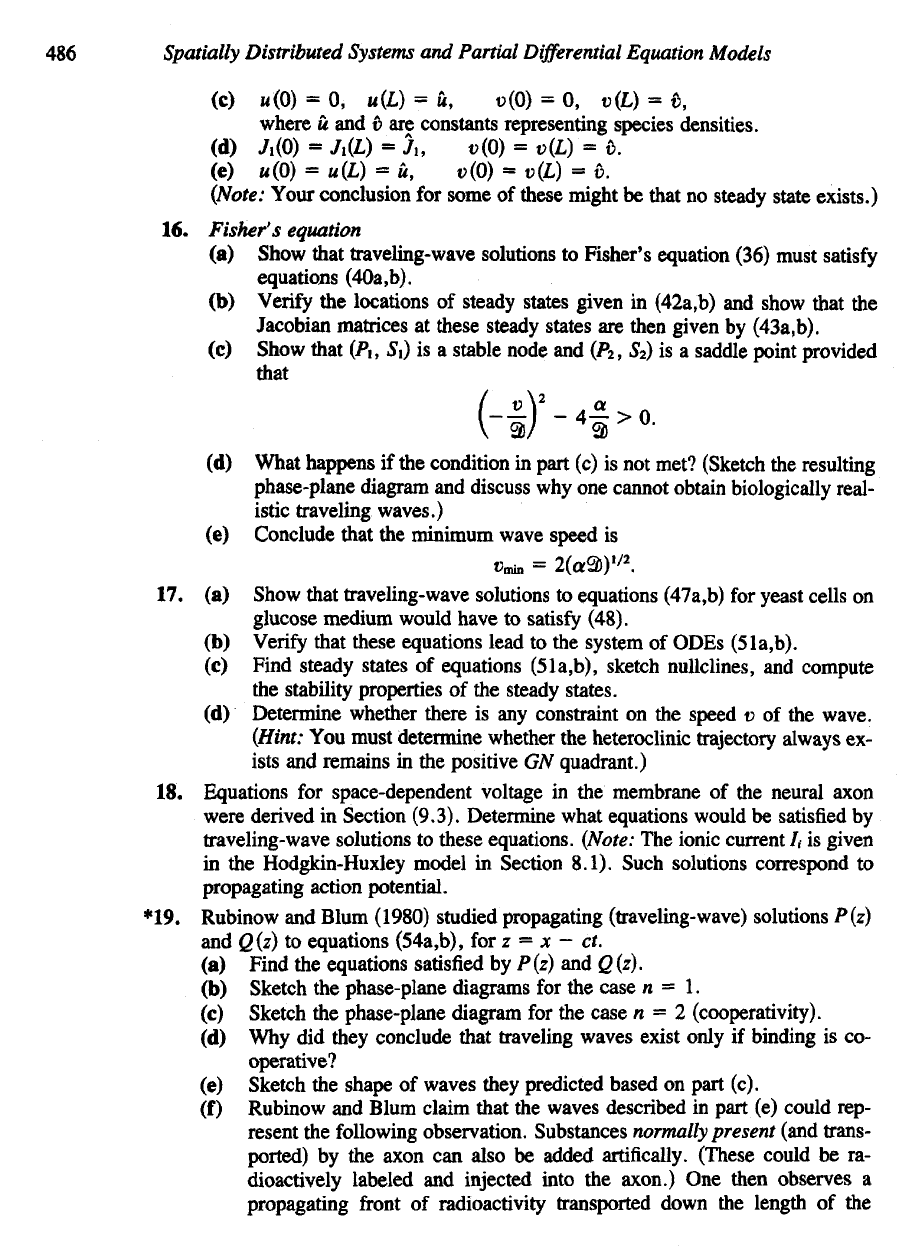
486
Spatially
Distributed
Systems
and
Partial
Differential
Equation
Models
(c)
«(0)
= 0,
u(L)
= fi,
o(0)
= 0,
v(L)
= v,
where
u and
t>
are
constants representing
species
den
(d)
/,(0)
=
/,(L)
= /,,
t?(0)
=
i?(L)
= 6.
(e)
«(0)
=
u(L)
= u,
u(0)
=
i3(L)
= e.
(Afote:
Your conclusion
for
some
of
these might
be
that
no
steady state exists.)
16.
Fisher's equation
(a)
Show that traveling-wave solutions
to
Fisher's
equation (36) must
satisfy
equations (40a,b).
(b)
Verify
the
locations
of
steady states given
in
(42a,b)
and
show that
the
Jacobian matrices
at
these steady states
are
then
given
by
(43a,b).
(c)
Show that (P\
t
S\) is a
stable node
and
(P
2
,
S
2
) is a
saddle point provided
that
(d)
What happens
if the
condition
in
part
(c) is not
met? (Sketch
the
resulting
phase-plane diagram
and
discuss
why one
cannot obtain biologically real-
istic traveling waves.)
(e)
Conclude that
the
minimum wave
speed
is
Dnun
=
2(a2))
1/2
.
17. (a)
Show that traveling-wave solutions
to
equations (47a,b)
for
yeast cells
on
glucose
medium would have
to
satisfy
(48).
(b)
Verify
that these equations lead
to the
system
of
ODEs (51a,b).
(c)
Find steady states
of
equations
(51a,b),
sketch nullclines,
and
compute
the
stability properties
of the
steady states.
(d)
Determine whether there
is any
constraint
on the
speed
v of the
wave.
(Hint:
You
must determine whether
the
heteroclinic trajectory always
ex-
ists
and
remains
in the
positive
GN
quadrant.)
18.
Equations
for
space-dependent voltage
in the
membrane
of the
neural axon
were derived
in
Section
(9.3).
Determine what equations would
be
satisfied
by
traveling-wave solutions
to
these equations.
(Note:
The
ionic current/,
is
given
in
the
Hodgkin-Huxley model
in
Section 8.1). Such solutions correspond
to
propagating action potential.
9. Rubinow
and
Blum (1980) studied propagating (traveling-wave) solutions P(z)
and
Q(z)
to
equations
(54a,b),
for z = x — ct.
(a)
Find
the
equations
satisfied
by
P(z)
and
Q(z).
(b)
Sketch
the
phase-plane diagrams
for the
case
n = 1.
(c)
Sketch
the
phase-plane diagram
for the
case
n = 2
(cooperativity).
(d) Why did
they conclude that traveling waves exist only
if
binding
is co-
operative?
(e)
Sketch
the
shape
of
waves they predicted based
on
part (c).
(f)
Rubinow
and
Blum claim that
the
waves described
in
part
(e)
could rep-
resent
the
following observation. Substances
normally
present (and trans-
ported)
by the
axon
can
also
be
added artifically. (These could
be ra-
dioactively
labeled
and
injected into
the
axon.)
One
then
observes
a
propagating
front
of
radioactivity transported down
the
length
of the
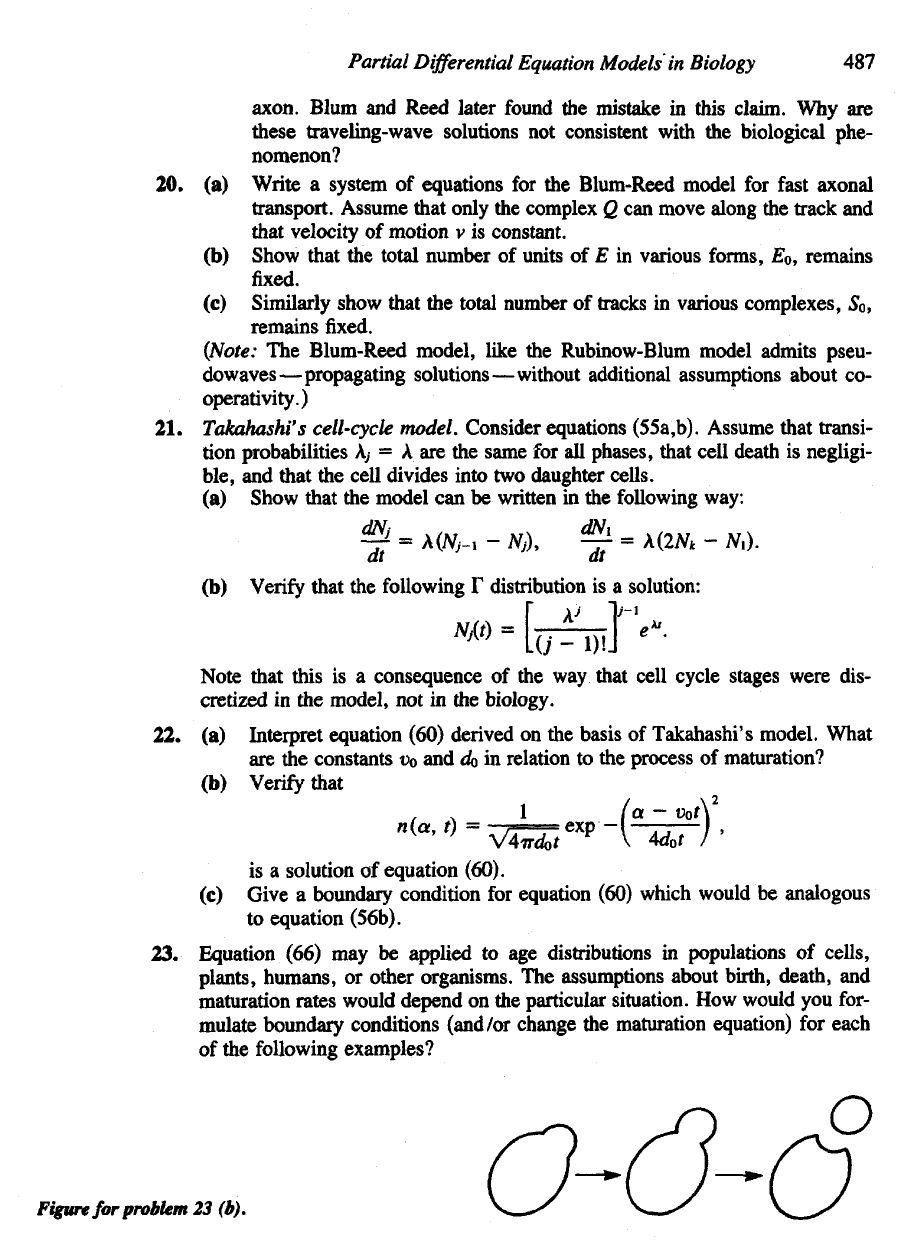
Partial
Differential
Equation
Models
in
Biology
487
axon. Blum
and
Reed later
found
the
mistake
in
this claim.
Why are
these traveling-wave solutions
not
consistent with
the
biological phe-
nomenon?
20. (a)
Write
a
system
of
equations
for the
Blum-Reed model
for
fast axonal
transport. Assume that only
the
complex
Q can
move along
the
track
and
that velocity
of
motion
v is
constant.
(b)
Show that
the
total mber
of
units
of E in
various forms, £"0, remains
fixed.
(c)
Similarly show that
the
total number
of
tracks
in
various complexes,
So,
remains
fixed.
(Note:
The
Blum-Reed model, like
the
Rubinow-Blum model admits pseu-
dowaves—propagating solutions—without additional assumptions about
co-
operativity.)
21.
Takahashi's
cell-cycle
model. Consider equations (55a,b). Assume that transi-
tion
probabilities
Ay
= A are the
same
for all
phases, that
cell
death
is
negligi-
ble,
and
that
the
cell divides into
two
daughter cells.
(a)
Show that
the
model
can be
written
in the
following way:
Note
that this
is a
consequence
of the way
that cell cycle stages were dis-
cretized
in the
model,
not in the
biology.
22. (a)
Interpret equation (60) derived
on the
basis
of
Takahashi's model. What
are the
constants
t>
0
and do in
relation
to the
process
of
maturation?
(b)
Verify that
Figure
for
problem
23
(b).
is
a
solution
of
equation (60).
(c)
Give
a
boundary condition
for
equation (60) which would
be
analogous
to
equation
(56b).
23.
Equation (66)
may be
applied
to age
distributions
in
populations
of
cells,
plants, humans,
or
other organisms.
The
assumptions about birth, death,
and
maturation
rates would depend
on the
particular situation.
How
would
you
for-
mulate
boundary conditions (and
/or
change
the
maturation equation)
for
each
of the
following examples?
(b)
Verify
that
the
following
F
distribution
is a
solution:
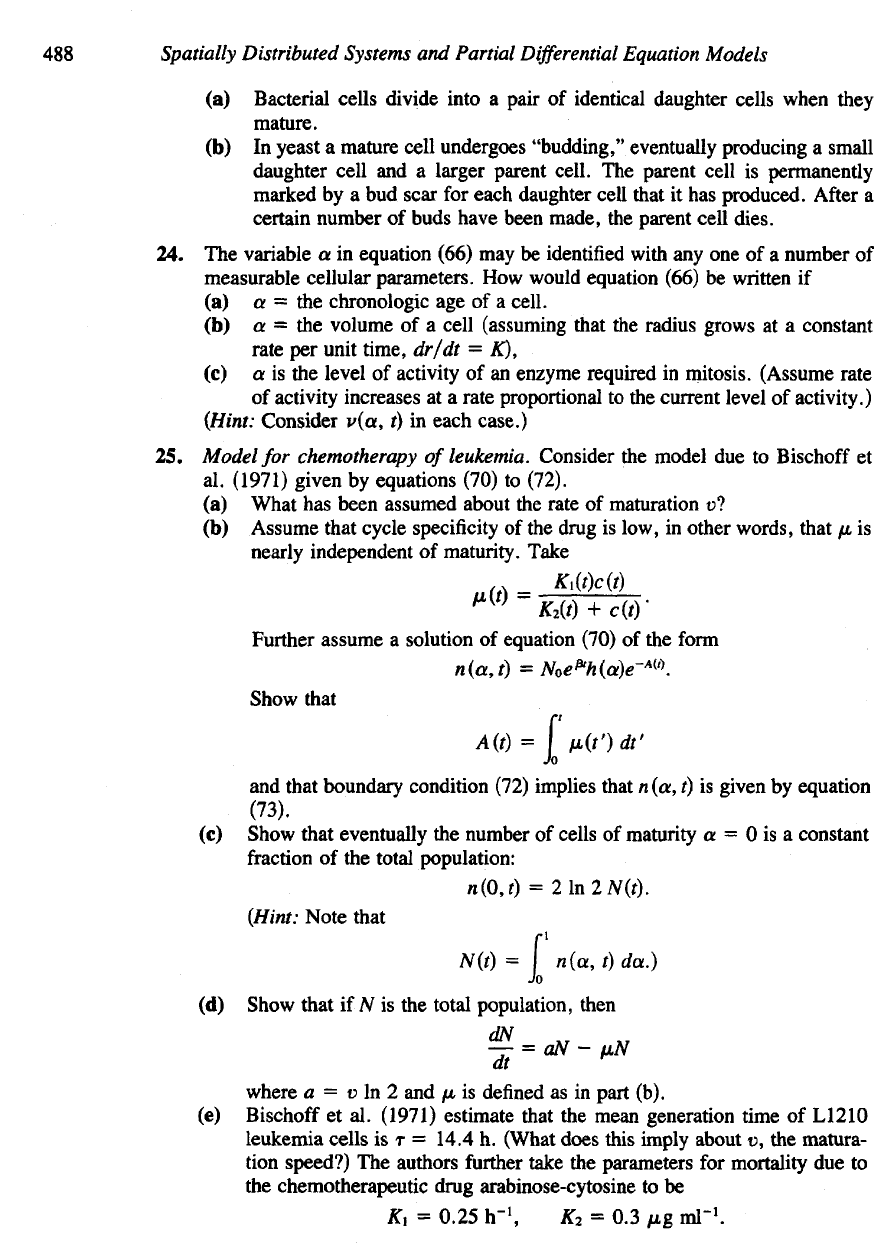
488
Spatially
Distributed Systems
and
Partial
Differential
Equation
Models
(a)
Bacterial
cells
divide into
a
pair
of
identical daught lls when they
mature.
(b) In
yeast
a
mature
cell
undergoes "budding," eventuall ucing
a
small
daughter
cell
and a
larger parent
cell.
The
parent cell
is
permanently
marked
by a bud
scar
for
each daughter cell that
it has
produced.
After
a
certain number
of
buds have been made,
the
parent
cell
dies.
24. The
variable
a in
equation (66)
may be
identified
with
any one of a
number
of
measurable cellular parameters.
How
would equation (66)
be
written
if
(a) a = the
chronologic
age of a
cell.
(b) a = the
volume
of a
cell (assuming that
the
radius grows
at a
constant
rate
per
unit time, dr/dt
= K),
(c) a is the
level
of
activity
of an
enzyme required
in
mitosis. (Assume r
of
activity increases
at a
rate proportional
to the
current level
of
activity.)
(Hint:
Consider
v(a,
t) in
each
case.)
25.
Model
for
chemotherapy
of
leukemia. Consider
the
model
due to
Bischoff
et
al.
(1971) given
by
equations (70)
to
(72).
(a)
What
has
been assumed about
the
rate
of
maturation
u?
(b)
Assume that cycle specificity
of the
drug
is
low,
in
other words, that
/u,
is
nearly independent
of
maturity. Take
and
that boundary condition (72) implies that
n (a, t) is
given
by
equation
(73).
(c)
Show that eventually
the
number
of
cells
of
maturity
a = 0 is a
constant
fraction
of the
total population:
where
a = v In 2 and /u is
defined
as in
part (b).
(e)
Bischoff
et al.
(1971) estimate that
the
mean generation time
of
L1210
leukemia
cells
is T —
14.4
h.
(What
does
this imply about
u, the
matura-
tion
speed?)
The
authors further take
the
parameters
for
mortality
due to
the
chemotherapeutic drug arabinose-cytosine
to be
Further assume
a
solution
of
equation (70)
of the
form
Show that
jo
(d)
Show that
if N is the
total population, then
(Hint:
Note that
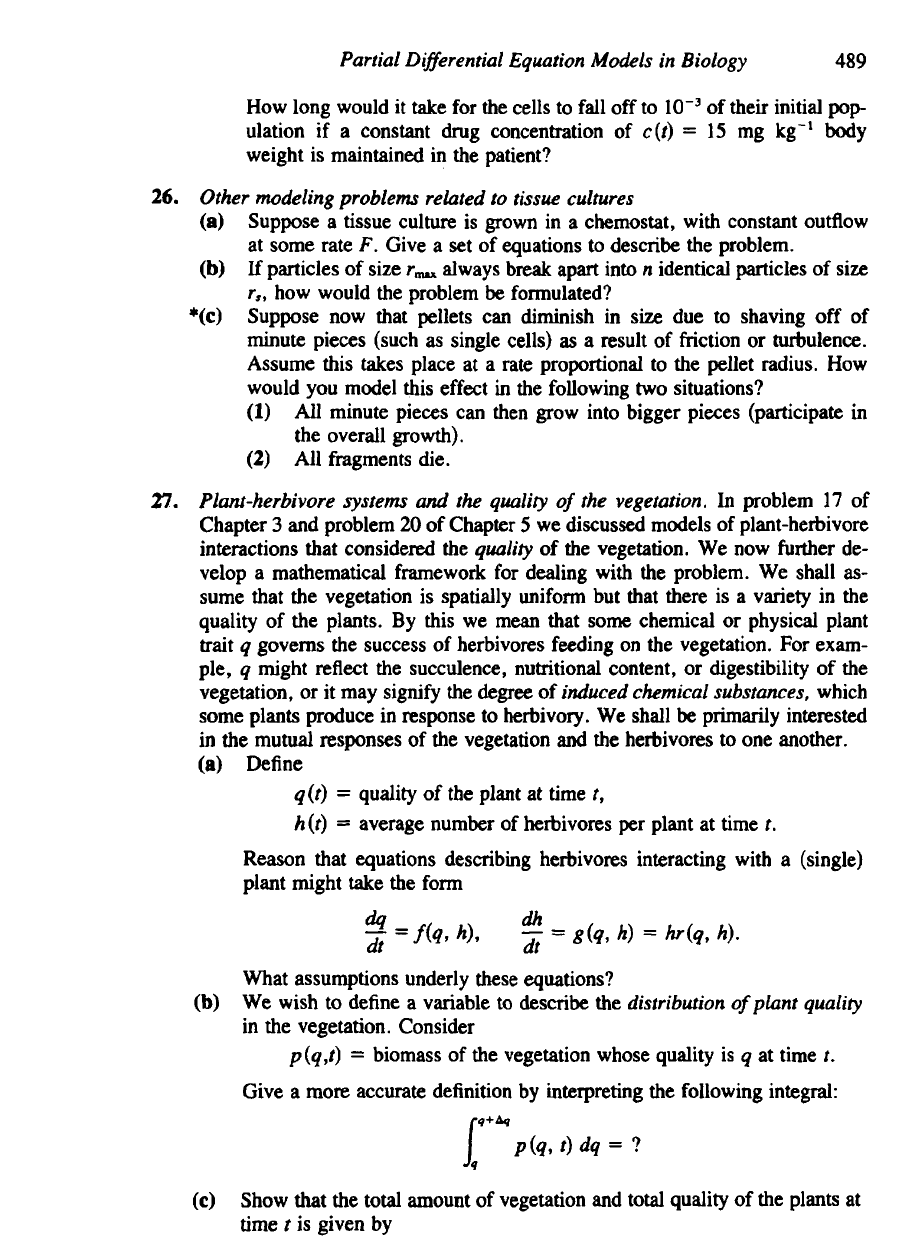
Partial
Differential
Equation
Models
in
Biology
489
How
long would
it
take
for the
cells
to
fall
off to
10~
3
of
their initial pop-
ulation
if a
constant drug concentration
of
c(t)
= 15 mg
kg"
1
body
weight
is
maintained
in the
patient?
26.
Other modeling problems
related
to
tissue
cultures
(a)
Suppose
a
tissue culture
is
grown
in a
chemostat, with constant
outflow
at
some rate
F.
Give
a set of
equations
to
describe
the
problem.
(b) If
particles
of
size
r^
always break apart into
n
identical particles
of
size
r
s
, how
would
the
problem
be
formulated?
*(c)
Suppose
now
that
pellets
can
diminish
in
size
due to
shaving
off of
minute
pieces (such
as
single cells)
as a
result
of
friction
or
turbulence.
Assume this takes place
at a
rate proportional
to the
pellet
radius.
How
would
you
model this
effect
in the
following
two
situations?
(1) All
minute
pieces
can
then grow into
bigger
pieces
(participate
in
the
overall growth).
(2)
All
fragments die.
27.
Plant-herbivore systems
and the
quality
of the
vegetation.
In
problem
17 of
Chapter
3 and
problem
20 of
Chapter
5 we
discussed models
of
plant-herbivore
interactions that considered
the
quality
of the
vegetation.
We now
further
de-
velop
a
mathematical framework
for
dealing with
the
problem.
We
shall
as-
sume that
the
vegetation
is
spatially uniform
but
that there
is a
variety
in the
quality
of the
plants.
By
this
we
mean that some chemical
or
physical plant
trait
q
governs
the
success
of
herbivores feeding
on the
vegetation.
For
exam-
ple,
q
might reflect
the
succulence, nutritional content,
or
digestibility
of the
vegetation,
or it may
signify
the
degree
of
induced
chemical substances, which
some plants produce
in
response
to
herbivory.
We
shall
be
primarily interested
in
the
mutual
responses
of the
vegetation
and the
herbivores
to one
another,
(a)
Define
q(t)
=
quality
of the
plant
at
time
t,
h(t)
=
average number
of
herbivores
per
plant
at
time
t.
Reason that equations describing herbivores interacting with
a
(single)
plant might take
the
form
What
assumptions underly these equations?
(b) We
wish
to
define
a
variable
to
describe
the
distribution
of
plant
quality
in
the
vegetation. Consider
p(q,t)
=
biomass
of the
vegetation whose quality
is q at
time
t.
Give
a
more accurate definition
by
interpreting
the
following integral:
(c)
Show that
the
total amount
of
vegetation
and
total quality
of the
plants
at
time
t is
given
by
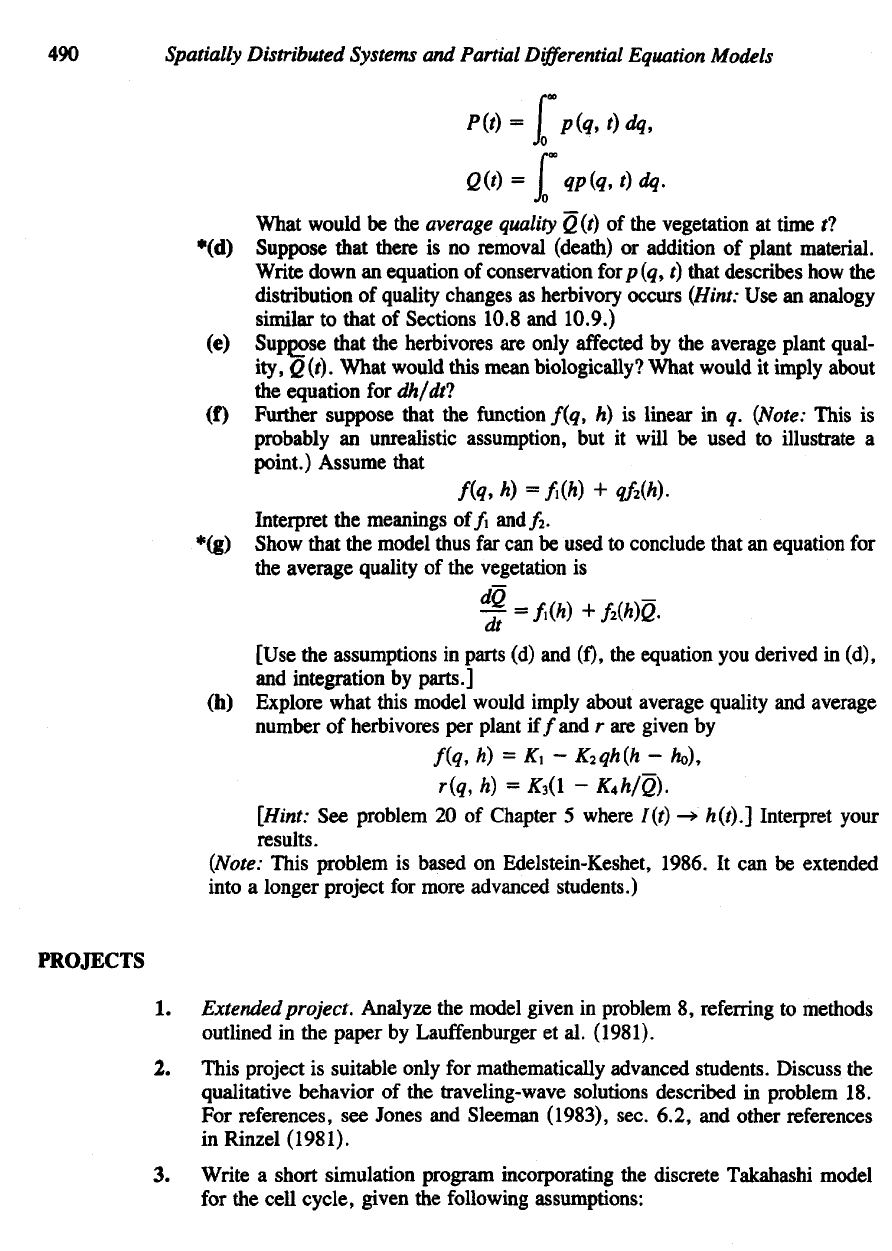
490
Spatially
Distributed
Systems
and
Partial
Differential
Equation
Models
What
would
be the
average
quality
Q
(t)
of the
vegetation
at
time
t?
"(d)
Suppose
that there
is no
removal (death)
or
addition
of
plant material.
Write down
an
equation
of
conservation
for p (4, t)
that
describes
how the
distribution
of
quality changes
as
herbivory occurs
(Hint:
Use an
analogy
similar
to
that
of
Sections 10.8
and
10.9.)
(e)
Suppose that
the
herbivores
are
only
affected
by the
average plant qual-
ity, Q(t). What would this mean
biologically?
What would
it
imply about
the
equation
for
dh/dtl
(f)
Further suppose that
the
function
f(q,
h) is
linear
in q.
(Note:
This
is
probably
an
unrealistic assumption,
but it
will
be
used
to
illustrate
a
point.) Assume that
f(q,
h)
=fi(h)
+qf2(h)•
Interpret
the
meanings
of f1 and f
2
.
"(g) Show that
the
model thus
far can be
used
to
conclude that
an
equation
for
the
average
quality
of the
vegetation
is
^|=/i<ft)+/2<*)B.
[Use
the
assumptions
in
parts
(d) and
(f),
the
equation
you
derived
in
(d),
and
integration
by
parts.]
h)
Explore what this model would imply about average quality
and
average
number
of
herbivores
per
plant
if/and
r are
given
by
f(q,h)=K
l
-
K
2
qh(h-h
0
),
r(q,
h) =
#
3
(1
-
K
4
h/Q).
[Hint:
See
problem
20 of
Chapter
5
where I(i)
—>
h(t).]
Interpret your
results.
(Note:
This problem
is
based
on
Edelstein-Keshet, 1986.
It can be
extended
into
a
longer project
for
more advanced students.)
PROJECTS
1.
Extended
project. Analyze
the
model given
in
lem
8,
referring
to
methods
outlined
in the
paper
by
Lauffenburger
et al.
(1981).
2.
This project
is
suitable only
for
mathematically advanced students. Discuss
the
qualitative behavior
of the
traveling-wave solutions described
in
problem
18.
For
references,
see
Jones
and
Sleeman (1983), sec. 6.2,
and
other references
in
Rinzel
(1981).
3.
Write
a
short simulation program incorporating
the
discrete Takahashi model
for
the
cell
cycle,
given
the
following assumptions:
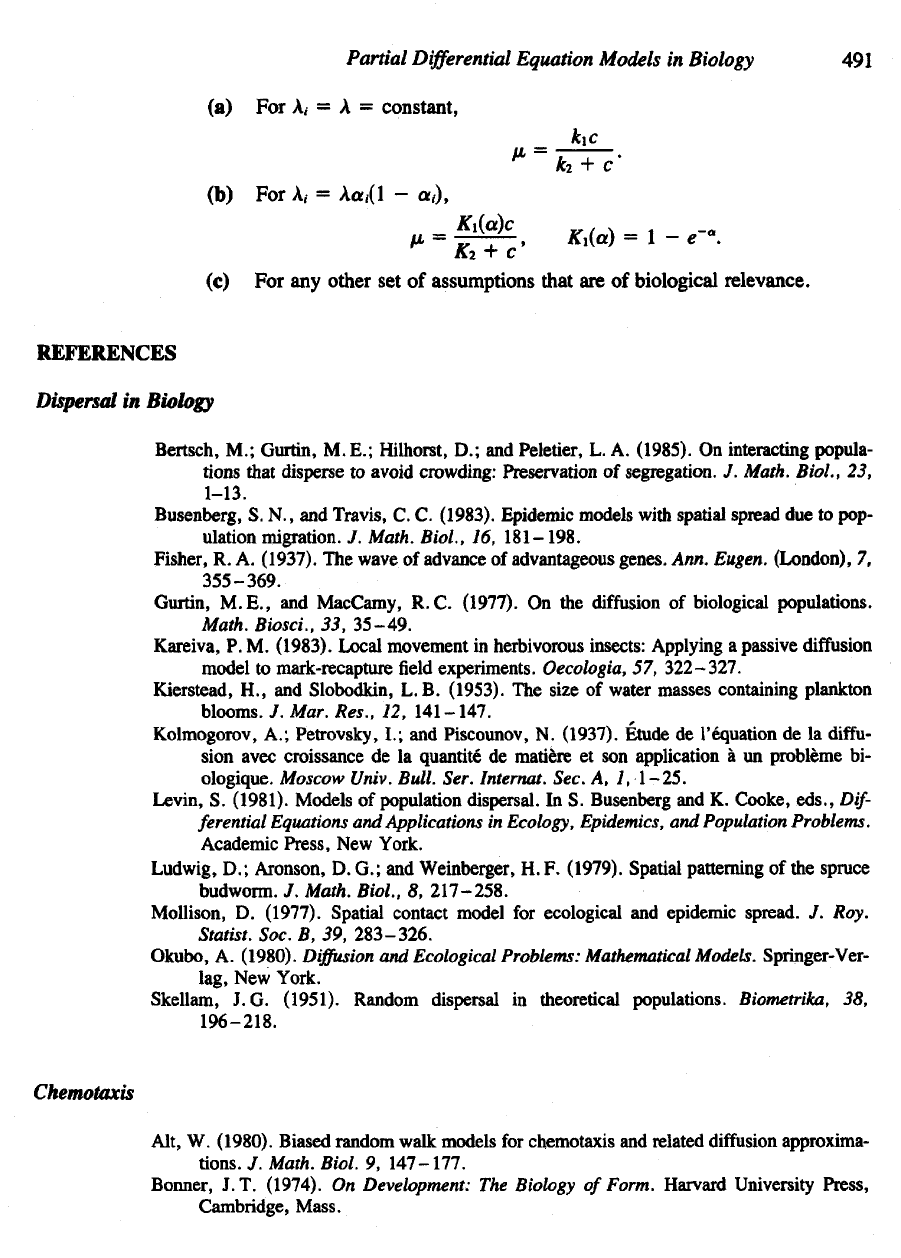
Partial
Differential
Equation
Models
in
Biology
491
REFERENCES
Dispersal
in
Biology
Chemotaxis
Bertsch,
M.;
Gurtin,
M. E.;
Hilhorst,
D.; and
Peletier,
L. A.
(1985).
On
interacting popula-
tions
that
disperse
to
avoid crowding: Preservation
of
segregation.
J.
Math.
Biol.,
23,
1-13.
Busenberg,
S. N., and
Travis,
C. C.
(1983).
Epidemic models with spatial spread
due to
pop-
ulation migration.
J.
Math.
Biol.,
16,
181-198.
Fisher,
R. A.
(1937).
The
wave
of
advance
of
advantageous genes. Ann. Eugen. (London),
7,
355-369.
Gurtin, M.E.,
and
MacCamy,
R. C.
(1977).
On the
diffusion
of
biological populations.
Math.
Biosci.,
33,
35-49.
Kareiva,
P. M.
(1983).
Local movement
in
herbivorous
insects:
Applying
a
passive
diffusion
model
to
mark-recapture
field
experiments. Oecologia,
57,
322-327.
Kierstead,
H., and
Slobodkin,
L. B.
(1953).
The
size
of
water masses containing plankton
blooms.
J.
Mar. Res.,
12, 141
-147.
Kolmogorov,
A.;
Petrovsky,
I.; and
Piscounov,
N.
(1937). Etude
de
1'equation
de la
diffu-
sion avec croissance
de la
quantite
de
matiere
et son
application
a un
probleme
bi-
ologique.
Moscow
Univ.
Bull. Ser. Internal. Sec.
A, 1,
1-25.
Levin,
S.
(1981). Models
of
population dispersal.
In S.
Busenberg
and K.
Cooke, eds.,
Dif-
ferential
Equations
and
Applications
in
Ecology,
Epidemics,
and
Population
Problems.
Academic Press,
New
York.
Ludwig,
D.;
Aronson,
D. G.; and
Weinberger,
H. F.
(1979). Spatial patterning
of the
spruce
budworm.
J.
Math. Biol.,
8,
217–258.
Mollison,
D.
(1977). Spatial contact model
for
ecological
and
epidemic spread.
J.
Roy.
Statist. Soc.
B, 39,
283-326.
Okubo,
A.
(1980).
Diffusion
and
Ecological Problems:
Mathematical
Models.
Springer-Ver-
lag,
New
York.
Skellam,
J. G.
(1951). Random dispersal
in
theoretical populations. Biome
8,
196-218.
Alt,
W.
(1980).
Biased random walk models
for
chemotaxis
and
related
diffusion
approxima-
tions. /.
Math. Biol.
9,
147–177.
Bonner,
J. T.
(1974).
On
Development:
The
Biology
of
Form. Harvard University Press,
Cambridge, Mass.
(c) For any
other
set of
assumptions
that
are of
biological
relevance.

492
Spatially
Distributed
Systems
and
Partial
Differential
Equation
Models
Keller,
E. F., and
Segel,
L. A.
(1970). Initiation
of
slime mold aggregation viewed
as an in-
stability.
7.
Theor. Biol.,
26,
399-415.
Keller,
E. F., and
Segel,
L. A.
(1971). Model
for
chemotaxis.
J.
Theor.
Biol,
30,
225–234.
Lauffenburger,
D. A.,
(1982). Influence
of
external concentration
fluctuations on
leukocyte
chemotactic orientation. CellBiophys.,
4,
177-209.
Lauffenburger,
D. A., and
Kennedy,
C.R.
(1983). Localized bacterial infection
in a
dis-
tributed model
for
tissue inflammation.
J.
Math. Biol.,
16,
141–163.
Lovely,
P. S., and
Dahlquist,
F. W.
(1975). Statistical measures
of
bacterial motility
and
chemotaxis.
J.
Theor.
Biol,
50,
477-496.
Okubo,
A.
(1986). Dynamical aspects
of
animal grouping: Swarms, schools,
flocks, and
herds.
Adv.
inBiophys.,
22,
1-94.
Segel,
L. A.
(1977).
A
theoretical study
of
receptor mechanisms
in
bacterial chemotaxis.
SIAMJ.
Appl. Math.,
32,
653-665.
Segel,
L. A.;
Chet,
L; and
Henis,
Y.
(1977).
A
simple quantitative assay
for
bacterial motil-
ity.
J.
Gen.
Microbiol,
98,
329–337.
Segel,
L. A., and
Jackson,
J.L.
(1973). Theoretical analysis
of
chemotactic movement
in
bacteria.
J.
Mechanochem. Cell
Motil,
2,
25-34.
Zigmond,
S. H.
(1977). Ability
of
polymorphonuclear leukocytes
to
orient
in
gradients
of
chemotactic
factors.
J.
Cell
Biol.,
75,
606-616.
Traveling
Waves
and
Fisher's Equation
See
Fisher (1937), Kolmogorov
et al.
(1937),
and the
following:
Fife,
P.C.
(1979).
Mathematical
Aspects
of
Reacting
and
Diffusing
Systems.
Springer-Ver-
lag,
New
York.
Hoppensteadt,
F. C.
(1975).
Mathematical
Theories
of
Populations:
Demographics,
Genet-
ics,
and
Epidemics. (Regional Conference Series
in
Applied Mathematics,
no.
20).
SIAM, Philadelphia.
Murray,
J. D.
(1977).
Lectures
on
Nonlinear
Differential
Equation
Models
in
Biology.
Clarendon
Press,
Oxford,
sec. 5.3.
Odell,
G. M.
(1980).
Biological waves.
In L. A.
Segel,
ed.,
Mathematical
Models
in
Molecu-
lar
and
Cellular Biology. Cambridge University Press, Cambridge.
The
Cell
Cycle
and
Models
for
Cancer
Chemotherapy
Aroesty,
J.;
Lincoln,
T.,
Shapiro,
N.; and
Boccia,
G.
(1973). Tumor growth
and
chemother-
apy: Mathematical methods, computer simulations,
and
experimental foundations.
Math.
Biosci.,
17,
243-300.
Bischoff,
K. B.;
Himmelstein,
K. J.;
Dedrick,
R. L.; and
Zaharko,
D. S.
(1973). Pharmacoki-
netics
and
cell population growth models
in
cancer chemotherapy. Chem.
Eng.
Med.
Biol,
(Advances
in
Chemistry
Series.),
118, 47-64.
McKendrick,
A. G.
(1926). Application
of
mathematics
to
medical problems. Proc. Edin.
Math.
Soc.,
44,
98–130.
Merkle,
T.C.;
Stuart,
R.N.;
and
Gofman,
J.W.
(1965).
The
Calculation
of
Treatment
Schedules
for
Cancer
Chemotherapy.
UCRL-14505.
University
of
California
Lawrence Livermore Radiation Laboratory, Livermore, Calif.
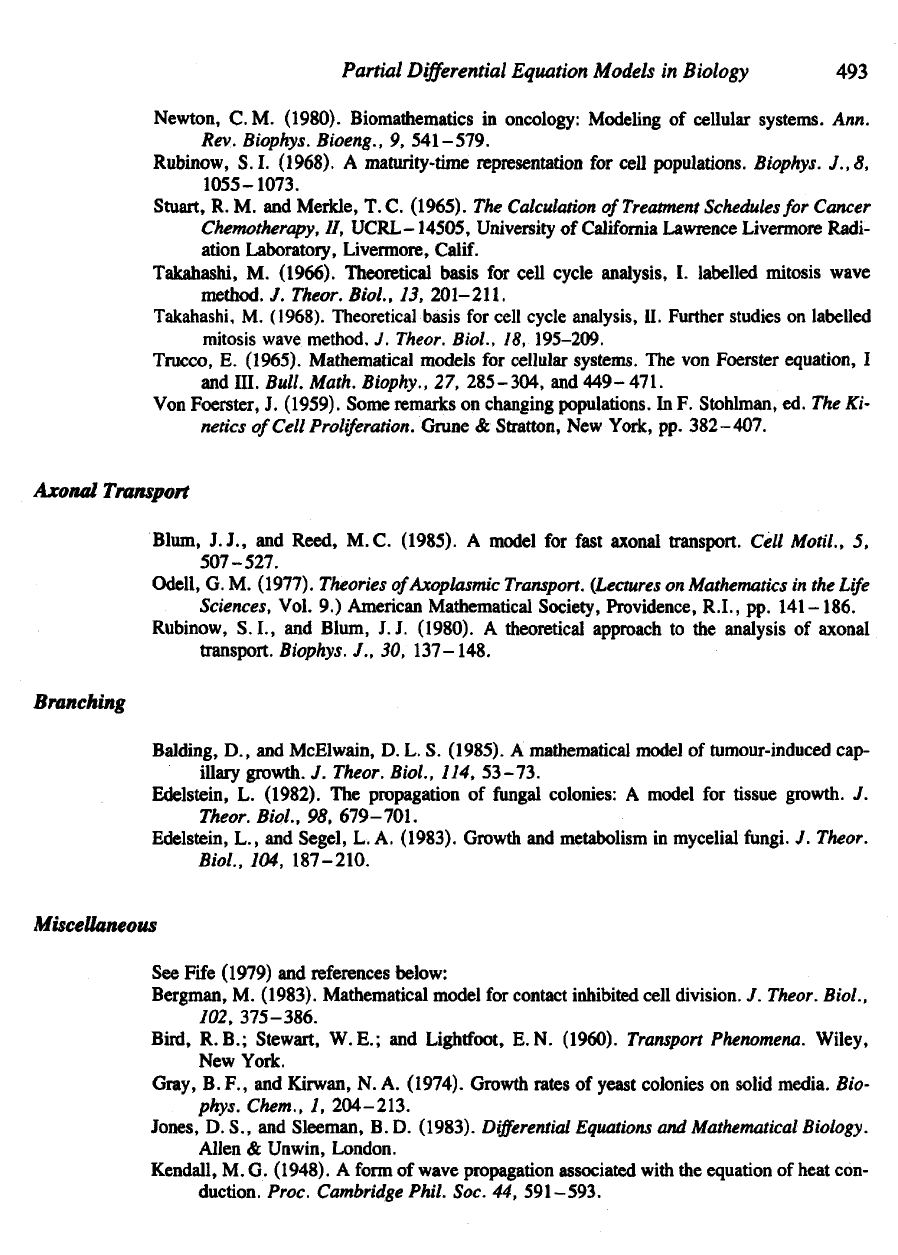
Partial
Differential
Equation Models
in
Biology
493
Newton,
C. M.
(1980).
Biomathematics
in
oncology: Modeling
of
cellular systems. Ann.
Rev. Biophys. Bioeng.,
9,
541–579.
Rubinow, S.I.
(1968).
A
maturity-time representat
for
cell
populations. Biophys. J.,8,
1055-1073.
Stuart,
R. M. and
Merkle,
T. C.
(1965).
The
Calculation
of
Treatment
Schedules
for
Cancer
Chemotherapy,
II,
UCRL-14505,
University
of
California Lawrence Livermore Radi-
ation Laboratory, Livermore, Calif.
Takahashi,
M.
(1966).
Theoretical basis
for
cell cycle analysis,
I.
labelled mitosis wave
method.
J.
Theor.
Biol.,
13,
201-211.
Takahashi,
M.
(1968). Theoretical basis
for
cell cycle analysis,
II.
Fur studies
on
labelled
mitosis
wave
method.
J.
Theor. Biol.,
18,
195–209.
Trucco,
E.
(1965).
Mathematical models
for
cellular systems.
The von
Foerster
equation,
I
and
III. Bull. Math. Biophy.,
27,
285-304,
and
449- 471.
Von
Foerster,
J.
(1959). Some remarks
on
changing populations.
In F.
Stohlman,
ed. The Ki-
netics
of
Cell
Proliferation.
Grune
&
Stratton,
New
York,
pp.
382-407.
Axonal
Transport
Branching
Blum,
J.J.,
and
Reed, M.C.
(1985).
A
model
for
fast
axonal transport. Cell Motil.,
5,
507-527.
Odell,
G. M.
(1977). Theories
ofAxoplasmic
Transport.
(Lectures
on
Mathematics
in the
Life
Sciences,
Vol.
9.)
American Mathematical Society, Providence, R.I.,
pp.
141–186.
Rubinow, S.I.,
and
Blum,
J. J.
(1980).
A
theoretical approach
to the
analysis
of
axonal
transport. Biophys.
J., 30,
137–148.
Balding,
D., and
McElwain,
D. L. S.
(1985).
A
mathematical model
of
tumour-induced cap-
illary growth.
J.
Theor. Biol., 114,
53–73.
Edelstein,
L.
(1982).
The
propagation
of
fungal
colonies:
A
model
for tissue
growth.
J.
Theor.
Biol.,
98,
679-701.
Edelstein,
L., and
Segel,
L. A.
(1983). Growth
and
metabolism
in
mycelial
fungi.
J.
Theor.
Biol.,
104,
187-210.
Miscellaneous
See
Fife (1979)
and
references below:
Bergman,
M.
(1983). Mathematical model
for
contact inhibited cell division.
J.
Theor.
Biol.,
102,
375-386.
Bird,
R. B.;
Stewart, W.E.;
and
Lightfoot, E.N. (1960).
Transport
Phenomena. Wiley,
New
York.
Gray,
B. F., and
Kirwan,
N. A.
(1974).
Growth rates
of
yeast
colonies
on
solid media. Bio-
phys. Chem.,
1,
204-213.
Jones,
D. S., and
Sleeman,
B. D.
(1983).
Differential
Equations
and
Mathematical
Biology.
Allen
&
Unwin, London.
Kendall,
M. G.
(1948).
A
form
of
wave propagation associated
with
the
equation
of
heat
duction.
Proc.
Cambridge
Phil. Soc.
44,
591-593.
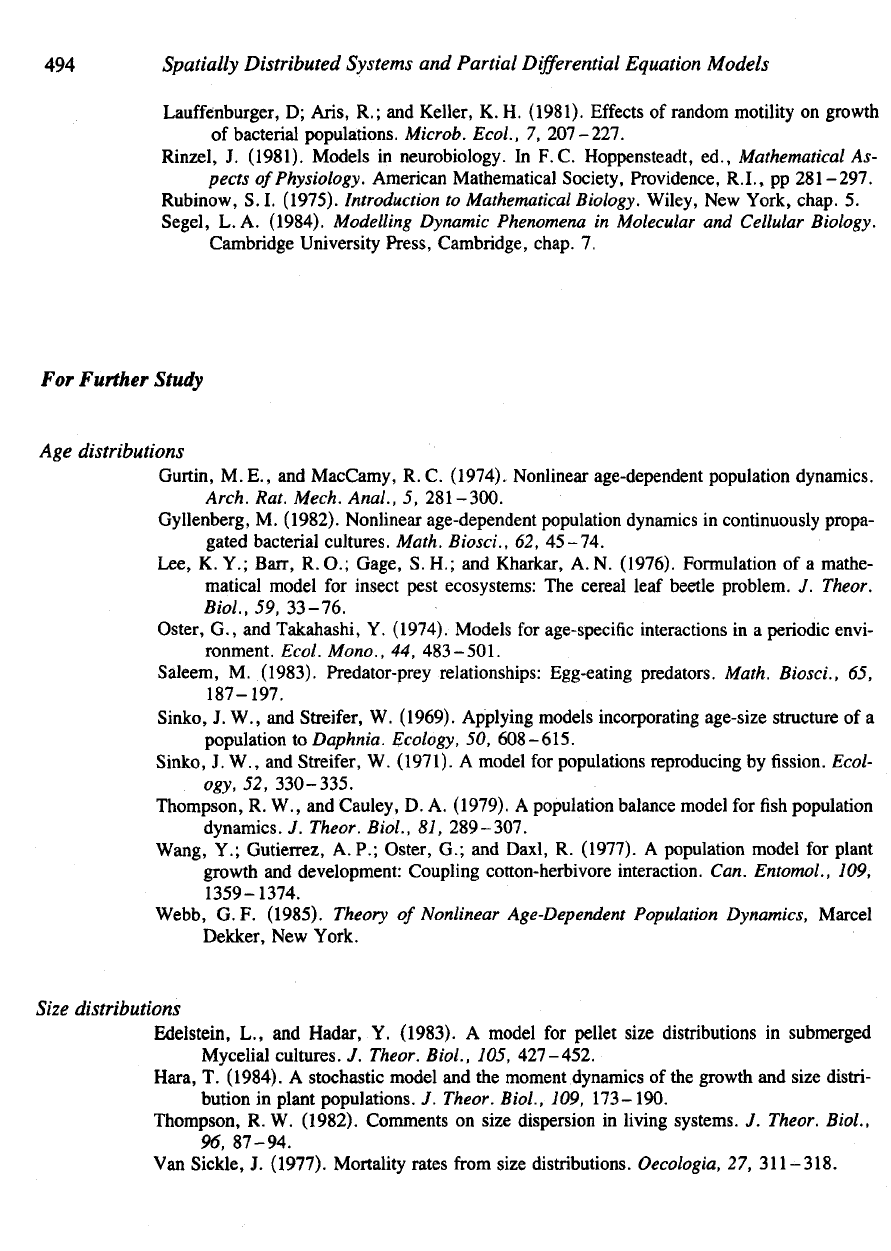
494
Spatially
Distributed
Systems
and
Partial
Differential
Equation
Models
Lauffenburger,
D;
Aris,
R.; and
Keller,
K. H.
(1981).
Effects
of
random motility
on
growth
of
bacterial populations. Microb.
Ecol.,
7,
207-227.
Rinzel,
J.
(1981). Models
in
neurobiology.
In F. C.
Hoppensteadt,
ed.,
Mathematical
As-
pects
of
Physiology. American Mathematical Society, Providence,
R.I.,
pp
281–297.
Rubinow,
S. I.
(1975). Introduction
to
Mathematical Biology. Wiley,
New
York, chap.
5.
Segel,
L. A.
(1984). Modelling Dynamic Phenomena
in
Molecular
and
Cellular Biology.
mbridge University Press, Cambridge, chap.
7.
For
Further
Study
Age
distributions
Gurtin,
M. E., and
MacCamy,
R. C.
(1974). Nonlinear age-dependent population dynamics.
Arch.
Rat.
Mech.
Anal.,
5,
281–300.
Gyllenberg,
M.
(1982). Nonlinear age-dependent population
dynamics
in
continuously propa-
gated bacterial cultures. Math.
Biosci.,
62,
45–74.
Lee,
K. Y.;
Barr,
R. O.;
Gage,
S. H.; and
Kharkar,
A. N.
(1976). Formulation
of a
mathe-
matical model
for
insect pest ecosystems:
The
cereal
leaf
beetle problem.
J.
Theor.
Biol.,
59,
33–76.
Oster,
G., and
Takahashi,
Y.
(1974). Models
for
age-specific interactions
in a
periodic envi-
ronment.
Ecol.
Mono.,
44,
483–501.
Saleem,
M.
(1983). Predator-prey relationships: Egg-eating predators. Math.
Biosci.,
65,
187-197.
Sinko,
J. W., and
Streifer,
W.
(1969). Applying models incorporating age-size structure
of a
population
to
Daphnia. Ecology,
50,
608-615.
Sinko,
J. W., and
Streifer,
W.
(1971).
A
model
for
populations reproducing
by fission.
Ecol-
ogy,
52,
330-335.
Thompson,
R. W., and
Cauley,
D. A.
(1979).
A
population balance model
for fish
population
dynamics.
J.
Theor.
Biol.,
81,
289–307.
Wang,
Y.;
Gutierrez,
A. P.;
Oster,
G.; and
Daxl,
R.
(1977).
A
population model
for
plant
growth
and
development: Coupling cotton-herbivore interaction.
Can.
Entomol.,
109,
1359-1374.
Webb,
G. F.
(1985).
Theory
of
Nonlinear Age-Dependent Population Dynamics, Marcel
Dekker,
New
York.
Size
distributions
Edelstein,
L., and
Hadar,
Y.
(1983).
A
model
for
pellet size distributions
in
submerged
Mycelial cultures.
J.
Theor.
Biol.,
105,
427–452.
Hara,
T.
(1984).
A
stochastic model
and the
moment dynamics
of the
growth
and
size distri-
bution
in
plant populations.
J.
Theor.
Biol.,
109, 173-190.
Thompson,
R. W.
(1982).
Comments
on
size dispersion
in
living systems.
J.
Theor.
Biol.,
96,
87-94.
Van
Sickle,
J.
(1977). Mortality rates
from
size distributions. Oecologia,
27,
311-318.

Partial
Differential
Equation Models
in
Biology
495
Other Structured-Population Models
Edelstein-Keshet,
L.
(1986).
Mathematical theory
for
plant-herbivore systems.
J.
Math.
Biol.,
24,
25–58.
Heijmans,
H. J. A. M.
(1985). Dynamics
of
structured populations.
PhD
t is, University
of
Amsterdam.
Metz,
J. A. J., and
Diekmann,
O.,
eds. (1986).
The
dynamics
of
physiologically
structured
populations.
Lecture notes
in
Biomathematics
68,
Springer-Verlag, Berlin.
